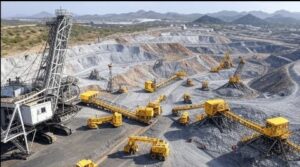TORONTO, ONTARIO–(Marketwire -01/09/12)- All amounts are in United States dollars unless stated otherwise.
Alamos Gold Inc. (TSX: AGI.TO – News) (“Alamos” or the “Company”) reports fourth quarter and full year 2011 operating results. The Company is also providing its 2012 production guidance and operating, development and exploration budgets.
Fourth Quarter and Full Year 2011 Operating Results
In the fourth quarter of 2011, the Mulatos Mine produced 46,500 ounces of gold at a cash operating cost that is expected to be within the Company’s guidance of $365 to $390 per ounce, exclusive of the 5% royalty. Gold production for the year ended December 31, 2011 was 153,000 ounces, at the midpoint of the Company’s annual production guidance of 145,000 to 160,000 ounces.
The Company sold 45,224 ounces of gold in the fourth quarter of 2011 for record revenues of $76.3 million, a 24% increase over revenues of $60.8 million in the same period of 2010. While developing the Escondida zone during the fourth quarter, the Company continued to encounter ore-grade material that had been classified as waste in the development plan. The Company estimates that approximately 3,000 ounces were sold from ore-grade material from the Escondida zone in the fourth quarter of 2011, which will be offset against the capital costs of the Escondida development.
Average crusher throughput for the fourth quarter of 2011 achieved record levels of 16,000 tonnes of ore stacked per day (“tpd”). Crusher throughput improved substantially throughout the year, with full year 2011 crusher throughput of 14,100 tpd, representing an 8% increase over the 13,000 tpd achieved in 2010.
The average grade mined in the fourth quarter of 2011 was 1.33 grams per tonne of gold (“g/t Au”), higher than the Company’s budgeted grade of 1.24 g/t Au. The higher grade was attributed to ore encountered while developing the Escondida zone that had been modeled as waste in the development plan. In the fourth quarter, approximately 250,000 tonnes grading 1.50 g/t Au from the Escondida zone was stacked on the leach pad. The average grade mined for 2011 was 1.31 g/t Au, which is above the Company’s 2011 budget of 1.24 g/t Au.
In the fourth quarter of 2011, the recovery ratio(1) was 74%, substantially higher than 61% in the third quarter of 2011. The improved recovery ratio for the fourth quarter over the third quarter was attributable to cyanide concentrations returning to normal levels. The recovery ratio in 2011 was 71%, in-line with the Company’s annual budget of 70%, and higher than the recovery ratio of 64% achieved last year.
Key operational metrics and production statistics for the fourth quarter and full-year 2011 and 2010 are presented in Table 1 at the end of this press release.
(1) “recovery ratio” is defined as the ratio of gold ounces produced
divided by the number of contained ounces stacked over a specific
period
2012 Production and Operating Guidance
The Company is forecasting strong production growth in 2012, between 200,000 and 220,000 ounces of gold at a cash operating cost of $365 to $390 per ounce of gold sold, exclusive of a 5% royalty. Including the 5% royalty and assuming a $1,600 gold price, this equates to a total cash cost range of $445 to $470 per ounce of gold sold. The Company expects gold produced from the gravity mill, which will process high-grade ore from Escondida, will add a minimum of 67,000 ounces of production in 2012 at a grade of 13.4 g/t Au. Based on bulk sample testing conducted in 2007, the Company believes that there is the potential for higher production from the gravity mill as a result of realizing positive grade reconciliation to the reserve grade.
The following key parameters form the basis for the 2012 production forecast and operating cost estimate:
— Combined gold recovery of 77% (heap leach ore, 72% recovery; mill ore,
90% recovery)
— Throughput: 17,500 tpd (includes 500 tpd from the gravity mill)
— Average grade: 1.33 g/t Au blended grade (heap leach ore, 1.0 g/t Au;
mill ore, 13.4 g/t Au)
— Waste-to-ore ratio of 0.64:1
— Mexican peso:United States dollar foreign exchange of 13:1
The Company expects these parameters to fluctuate throughout 2012 and as a result, these parameters should be treated as full-year averages and will not necessarily be reflective of quarterly operating results.
Commenting on Alamos’ 2012 guidance, Manley Guarducci, Vice-President and Chief Operating Officer, stated:
“The gravity mill is on-track to commence processing high-grade material from Escondida, which will significantly increase production to over 200,000 ounces per year for the next three years. In the main Mulatos pit, the expected lower average mined grade relative to prior years is a result of a lower cut-off grade associated with higher gold price assumptions. We believe that higher crusher throughput will offset the decline in the average grade mined and will allow the Company to maintain similar production levels from ongoing heap leach operations as in prior years. Our cash costs for 2012 are expected to be the same as in 2011, despite major increases in input costs, particularly in labour, diesel, and cyanide. Our ability to keep costs in check for 2012 reflects the addition of lower cash cost ounces from the gravity mill and continued operational efficiencies.”
2012 Mulatos Operating and Development Budget
The 2012 Mulatos capital and development budget is $26.0 million and includes the following key items:
Capital Expenditure – Mexico 2012 Budget
—————————————————————————-
Capitalized pre-stripping costs $ 9.7 million
Construction $ 3.0 million
Crusher Improvements $ 5.4 million
Sustaining Capital $ 7.9 million
—————————————————————————-
Total $ 26.0 million
—————————————————————————-
2012 Mulatos Exploration Budget
The 2012 Mulatos exploration budget is $8.6 million. The Company expects that approximately 65% of the 2012 exploration costs in Mexico will be expensed.
The locations of the Company’s regional and near-mine exploration targets within the Mulatos District are presented in figures 1 and 2, respectively.
In 2012, a minimum of 22,500 metres (“m”) of reverse-circulation (“RC”) and core drilling is planned at Mulatos, with a focus on the following targets:
— San Carlos Northeast – 5,000 m
— Compadres – 4,500 m
— East Estrella – 3,000 m
— Mulatos Mine Area (Escondida, El Victor North, and El Victor South) –
10,000 m
In addition to the drill programs outlined above, the Company also has a large reconnaissance-level exploration program planned for 2012 to assess several of its regional grassroots targets, including Puerto del Aire, San Nicolas, La Dura, La Palma, El Halcon and West Halcon, and Ostimuri.
2012 Agi Dagi, Camyurt, and Kirazli Development Budget
In Turkey, the 2012 development budget of $10.7 million includes costs incurred to complete the prefeasibility study (“PFS”) and environmental impact assessments (“EIA”), engineering, procurement, and construction management, and other corporate and administrative expenditures related to operations in Turkey.
Capital Expenditure – Turkey 2012 Budget
—————————————————————————-
Equipment $ 1.1 million
PFS/EIA $ 6.1 million
Administrative costs $ 3.5 million
—————————————————————————-
Total $ 10.7 million
—————————————————————————-
The Company plans to release the PFS in the second quarter of 2012, at which time an updated capital budget estimate for permitting, procurement, and construction costs related to the development of the Turkish projects will be provided.
The Company expects to capitalize the majority of the costs associated with the development of its Turkish assets during 2012.
2012 Agi Dagi, Camyurt, and Kirazli Exploration Budget
The Company’s 2012 exploration budget for its Agi Dagi, Camyurt, and Kirazli projects in Turkey is $9.8 million. The Company expects that it will be able to capitalize approximately 80% of its exploration costs in 2012.
Exploration activities will involve definition and expansion drilling at the Agi Dagi and Kirazli resource areas, in addition to drill testing grassroots targets on the concessions. The locations of the Company’s regional and near-mine exploration targets in Turkey are presented in Figure 3 below.
In 2012, the Company plans to complete a minimum of 29,600 meters of drilling in Turkey, with the focus on the following targets:
— Camyurt (Agi Dagi) – 7,500 m
— Baba and Deli (Agi Dagi) – 4,900 m
— Ihlamur, Fire Tower, and Aye Tepe (Agi Dagi) – 6,100 m
— Kirazli – 3,100 m
— Rockpile (Kirazli) – 8,000 m
Qualified Person
Mulatos exploration programs are conducted under the supervision of Ken Balleweg, B.Sc. Geological Engineering, M.Sc. Geology, Registered Professional Geologist, Alamos’ Mexico Exploration Manager. Mr. Balleweg is a Qualified Person as defined by National Instrument 43-101 of the Canadian Securities Administrators.
Agi Dagi and Kirazli exploration programs are conducted under the supervision of Dominique Fournier, B.Sc. Geology, PhD. Geology, Registered Professional Geologist, Alamos’ Exploration Manager – Turkey. Mr. Fournier is a Qualified Person as defined by National Instrument 43-101 of the Canadian Securities Administrators.
About Alamos
Alamos is an established Canadian-based gold producer that owns and operates the Mulatos Mine in Mexico, and has exploration and development activities in Mexico and Turkey. The Company employs nearly 500 people in Mexico and Turkey and is committed to the highest standards of environmental management, social responsibility, and health and safety for its employees and neighbouring communities. Alamos has over $210 million cash on hand, is debt-free, and unhedged to the price of gold. As of December 31, 2011 Alamos had 118,383,006 common shares outstanding (124,788,706 shares fully diluted), which are traded on the Toronto Stock Exchange under the symbol “AGI”.
Cautionary Non-GAAP Statements
The Company believes that investors use certain indicators to assess gold mining companies. They are intended to provide additional information and should not be considered in isolation or as a substitute for measures of performance prepared with GAAP. “Cash operating costs per ounce” and “total cash costs per ounce” as used in this analysis are non-GAAP terms typically used by gold mining companies to assess the level of gross margin available to the Company by subtracting these costs from the unit price realized during the period. These non-GAAP terms are also used to assess the ability of a mining company to generate cash flow from operations. There may be some variation in the method of computation of “cash operating costs per ounce” as determined by the Company compared with other mining companies. In this context, “cash operating costs per ounce” reflects the cash operating costs allocated from in-process and dore inventory associated with ounces of gold sold in the period. “Cash operating costs per ounce” may vary from one period to another due to operating efficiencies, waste-to-ore ratios, grade of ore processed and gold recovery rates in the period. “Total cash costs per ounce” includes “cash operating costs per ounce” plus applicable royalties. Cash operating costs per ounce and total cash costs per ounce are exclusive of exploration costs.
Cautionary Note
No stock exchange, securities commission or other regulatory authority has approved or disapproved the information contained herein. This News Release includes certain “forward-looking statements”. All statements other than statements of historical fact included in this release, including without limitation statements regarding forecast gold production, gold grades, recoveries, waste-to-ore ratios, total cash costs, potential mineralization and reserves, exploration results, and future plans and objectives of Alamos, are forward-looking statements that involve various risks and uncertainties. These forward-looking statements include, but are not limited to, statements with respect to mining and processing of mined ore, achieving projected recovery rates, anticipated production rates and mine life, operating efficiencies, costs and expenditures, changes in mineral resources and conversion of mineral resources to proven and probable reserves, and other information that is based on forecasts of future operational or financial results, estimates of amounts not yet determinable and assumptions of management.
Exploration results that include geophysics, sampling, and drill results on wide spacings may not be indicative of the occurrence of a mineral deposit. Such results do not provide assurance that further work will establish sufficient grade, continuity, metallurgical characteristics and economic potential to be classed as a category of mineral resource. A mineral resource which is classified as “inferred” or “indicated” has a great amount of uncertainty as to its existence and economic and legal feasibility. It cannot be assumed that any or part of an “indicated mineral resource” or “inferred mineral resource” will ever be upgraded to a higher category of resource. Investors are cautioned not to assume that all or any part of mineral deposits in these categories will ever be converted into proven and probable reserves.
Any statements that express or involve discussions with respect to predictions, expectations, beliefs, plans, projections, objectives, assumptions or future events or performance (often, but not always, using words or phrases such as “expects” or “does not expect”, “is expected”, “anticipates” or “does not anticipate”, “plans”, “estimates” or “intends”, or stating that certain actions, events or results “may”, “could”, “would”, “might” or “will” be taken, occur or be achieved) are not statements of historical fact and may be “forward-looking statements.” Forward-looking statements are subject to a variety of risks and uncertainties which could cause actual events or results to differ from those reflected in the forward-looking statements.
The Company has made projections of its annual production and operating costs based on annual budget which incorporates assumptions based on mining in sequence its mineral reserves at projected rates of tonnes and grade, assessing probable costs for mining and processing activities, projecting reasonable foreign exchange rates and achieving indicated rates of gold recovery derived from laboratory testing and historical experience. These assumptions are considered reasonable in the circumstances, but may be subject to change as additional information becomes available.
There can be no assurance that forward-looking statements will prove to be accurate and actual results and future events could differ materially from those anticipated in such statements. Important factors that could cause actual results to differ materially from Alamos’ expectations include, among others, risks related to international operations, the actual results of current exploration activities, conclusions of economic evaluations and changes in project parameters as plans continue to be refined as well as future prices of gold and silver, as well as those factors discussed in the section entitled “Risk Factors” in Alamos’ Annual Information Form. Although Alamos has attempted to identify important factors that could cause actual results to differ materially, there may be other factors that cause results not to be as anticipated, estimated or intended. There can be no assurance that such statements will prove to be accurate as actual results and future events could differ materially from those anticipated in such statements. Accordingly, readers should not place undue reliance on forward-looking statements.
Table 1: Production Summary & Statistics (1), (2)
—————————————————————————-
Q4 Q4 Change Change
2011 2010 (%) 2011 2010 (%)
—————————————————————————-
Ounces of Gold Produced
(3) 46,500 45,800 2% 153,000 156,000 -2%
Ore mined (tonnes,
000s) 1,475 1,152 28% 5,327 4,670 14%
Waste mined (tonnes,
000s) 612 701 -13% 3,486 3,651 -5%
—————————————————————————-
Total Material (tonnes,
000s) 2,087 1,853 13% 8,813 8,321 6%
Waste-to-Ore Ratio (x) 0.41 0.61 -33% 0.65 0.78 -17%
Ore Crushed (tonnes,
000s) 1,467 1,225 20% 5,164 4,729 9%
Grade (g/t Au) 1.33 1.37 -3% 1.31 1.60 -18%
—————————————————————————-
Contained Ounces
Stacked 62,970 54,070 16% 217,030 243,100 -11%
Ratio of Gold
Production to
Contained Ounces
Stacked 74% 85% -13% 71% 64% 11%
(1) All amounts for Q4-2011 and 2011 are preliminary and based on initial
end of period estimates. Final adjustments may be required.
(2) Certain numbers may not compute due to the effects of rounding and
truncation.
(3) Before final refinery settlements, which may result in increases or
decreases to reported gold production.
To view Figure 1, please visit the following link: http://media3.marketwire.com/docs/agi0109fig1.pdf.
To view Figure 2, please visit the following link: http://media3.marketwire.com/docs/agi0109fig2.pdf.
To view Figure 3, please visit the following link: http://media3.marketwire.com/docs/agi0109fig3.pdf.
The TSX has not reviewed and does not accept responsibility for the adequacy or accuracy of this release.
Alamos Gold Inc.
John A. McCluskey
President and Chief Executive Officer
(416) 368-9932 or 1 (866) 788-8801
Alamos Gold Inc.
Allan Candelario
Investor Relations
(416) 368-9932 x 406 or 1 (866) 788-8801

















